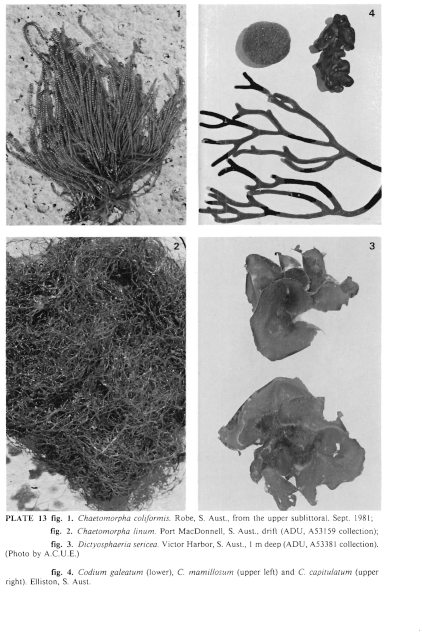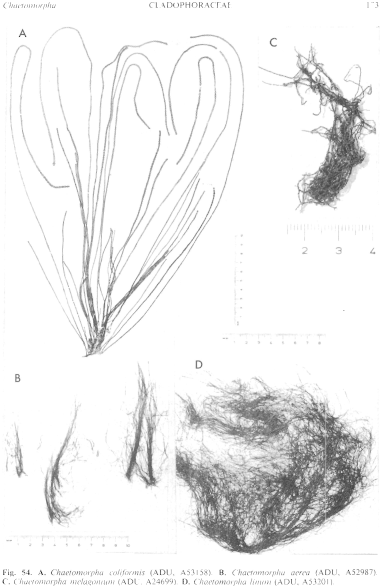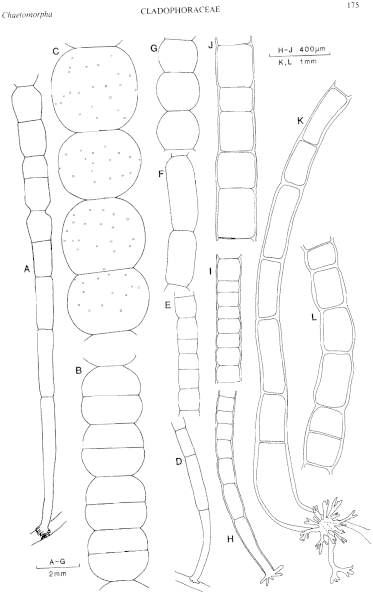|
|
|
|
|
|||||||||||
|
Electronic Flora of South Australia Species Fact Sheet
Phylum Chlorophyta – Order Cladophorales – Family Cladophoraceae
Selected citations: Womersley 1956: 356.
Synonyms
Conferva coliformis Montagne 1842: 16; 1845: 5.
Chaetomorpha darwinii (Hooker) Kützing 1849: 380. Chapman 1956: 458. Kornmann 1969b: 335. Womersley 1956: 356.
Conferva clavata var. darwinii Hooker 1847: 493, pl. 192 fig. 1.
Thallus (Pl. 13 fig. 1; Fig. 54A) light to deep green, erect, usually epiphytic (on Amphibolis, Heterozostera, Halopteris, Cladostephus, Ballia and other algae) with filaments single but often densely clustered on the host, forming spreading tufts commonly 10–40 (–60) cm long. Filaments increasing in diameter upwards and becoming moniliform (Fig. 55C), arising from an elongate basal cell (1–) 3–7 mm long (Fig. 55A, D), attached by a lobed, fimbriate holdfast but without descending rhizoids. Cells near base 0.5–1 mm in diameter and L/B (1–) 2–3 (–8); mid cells (Fig. 55B) 1.5–2.5 mm in diameter and L/B 0.5–1 (–1.5), 1.5–3 (–4) in calmer water forms (Fig. 55E); upper cells 2–4 (–5) mm in diameter and L/B 1–1.5 (–2); mid and upper cells usually markedly constricted at cross walls, subspherical (Fig. 55C,G). Cells turgid when living, collapsing on drying; wall 4–8(40) µm thick, chloroplasts fairly densely reticulate with numerous pyrenoids.
Reproduction: Reproduction: generations isomorphic, the gametophyte producing bi-flagellate isogametes and the sporophytes quadriflagellate zoo (meio) spores, discharged through scattered pores (Fig. 55C).
Type incorrectly reported from Toud I., Torres Strait (now Warrior Islet, 9°48'S, 142°57'E), in PC (see below); probably from Tasmania.
Selected specimens: Victor Harbor, S. Aust., 3–4 m deep on Cladostephus (Hone, 20.iii.1982; ADU, A52991). Robe, S. Aust., upper sublittoral pools (Womersley. 20.xii.1953; ADU, A19109). Port MacDonnell, S. Aust., drift on Heterozostera (Womersley, 15.v.1982; ADU, A53158). Port Arthur, Tas. (Perrin & Lucas, Feb. 1931, ADU, A47081). Triabunna, Tas. (Cribb, 18.iii.1950; ADU, A16055). Coles Bay, Great Oyster Bay, Tas., upper sublittoral on Heterozostera (Womersley, 4.xi.1982; ADU, A53828-"Marine Algae of southern Australia" No. 230).
Distribution: From Venus Bay, Eyre Peninsula, S. Aust. to Walkerville, Vic., and around Tasmania. New Zealand, South America.
Taxonomic notes: Ch. coliformis occurs on rough-water and moderate coasts, from just below low tide level to 3–4 m deep; it is often common in rock pools and occurs on rock and a variety of hosts.
It is regrettable that the well known epithet darwinii has to be replaced by the older coliformis, but there is little doubt that the type specimen of the latter is the common taxon of south-east Australian coasts and New Zealand, and that the type was mis-labelled as to locality. The Durville expedition of 1838–40 visited Tasmania and then New Zealand before sailing north to Toud I. (now Warrior Islet) in Torres Strait. No large-celled Chaetomorpha is known from northern Queensland (pers. comm. Drs A. B. Cribb and I. R. Price). Other apparently mis-labelled species of the Durville expedition have been recorded by Womersley (1979, p. 501).
The type of Ch. coliformis in PC has been examined. It is epiphytic on Heterozostera tastnanica (of which sections show a central and 6–7 peripheral outer vascular strands, plus fibre strands), and has relatively long cells in mid parts. It is very similar to forms from partly sheltered situations (such as ADU, A53828 from Coles Bay, Tas. and ADU, A53158 from Port MacDonnell, S. Aust.) which have long cells due to lack of cell divisions. This is a similar habitat to localities near Hobart, where the Durville expedition landed. Chapman (1956, p. 459) described three varieties from New Zealand, none of which deserve recognition.
The very large cells of Ch. coliformis have been used for physiological studies on ion movements across the cell membranes (e.g. Raven & Smith 1980).
References:
CHAPMAN, V.J. (1956). The marine algae of New Zealand. Part I. Myxophyceae and Chlorophyceae. J. Linn. Soc. Bot. 55 (360), 333–501, Plates 24–50.
HOOKER, J.D. (1847). The Botany of the Antarctic voyage of H.M. Discovery Ships Erebus and Terror, in the years 1839–1843. I. Flora Antarctica. (Reeve: London.)
KÜTZING, F.T. (1849). Species Algarum. (Leipzig.)
KÜTZING, F.T. (1853). Tabulae Phycologicae. Vol. 3. (Nordhausen.)
KORNMANN, P. (1969b). Gesetzmässigkeiten des Wachstums und der Entwicklung von Chaetomorpha darwinii (Chlorophyta, Cladophorales). Helgoländer wiss. Meeresunters. 19, 335–354.
MONTAGNE, C. (1842). Prodromus Generum Specierumque Phycearum Novarum in Itinere ad Polum Antarcticum. (Paris.)
MONTAGNE, C. (1845). Voyage au Pôle Sud et dans l'Océanie sur les Corvettes l'Astrolabe et la Zélée. I. Botanique. (Paris.)
RAVEN, J.A. & SMITH, F.A. (1980). Intracellular pH regulation in the giant-celled marine alga Chaetomorpha darwinii. J. exp. Bot. 31, 1357–1369.
WOMERSLEY, H.B.S. (1956). A critical survey of the marine algae of southern Australia. I. Chlorophyta. Aust. J. mar. freshw. Res. 7, 343–383.
WOMERSLEY, H.B.S. (1979). Southern Australian species of Polysiphonia Greville (Rhodophyta). Aust. J. Bot. 27, 459–528.
The Marine Benthic Flora of Southern Australia Part I complete list of references.
Publication:
Womersley, H.B.S. (31 May, 1984)
The Marine Benthic Flora of Southern Australia
Part I
©Board of the Botanic Gardens and State Herbarium, Government of South Australia
Illustrations in Womersley Part I, 1984: PLATE 13 fig. 1; FIGS 54A, 55 A–G.

Plate 13 enlarge
PLATE 13 Fig. 1. Chaetomorpha coliformis. Robe, S. Aust., from the upper sublittoral, Sept. 1981;
Fig. 2. Chaetomorpha linum. Port MacDonnell, S. Aust., drift (ADU, A53159 collection);
Fig. 3. Dictyosphaeria sericea. Victor Harbor, S. Aust., 1 m deep (ADU, A53381 collection). (Photo by A.C.U.E.)
Fig. 4. Codium galeatum (lower), C. mamillosum (upper left) and C. capitulatum (upper right). Elliston, S. Aust.

Figure 54 enlarge
Fig. 54. A. Chaetomorpha coliformis (ADU, A53158). B. Chaetomorpha aerea (ADU, A52987). C. Chaetomorpha melagonium (ADU, A24699). D. Chaetomorpha linum (ADU, A53201).

Figure 55 enlarge
Fig. 55. A–C. Chaetomorpha coliformis (ADU, A52991). A. Base of filament. B. Mid part of filament with recent divisions. C. Upper part of filament, with zooid discharge pores. D–G. Chaetomorpha coliformis (ADU, A53158). D. Base of filament. E. Mid part of filament. F. Upper part of filament. G. Uppermost cells of filament. H–J. Chaetomorpha aerea (ADU, A52987). H. Base of filament. I. Mid part of filament. J. Upper part of filament. K,L. Chaetomorpha melagonium (ADU, A24699). K. Base of filament. L. Upper part of filament.

|
Email Contact: State Herbarium of South Australia |

|